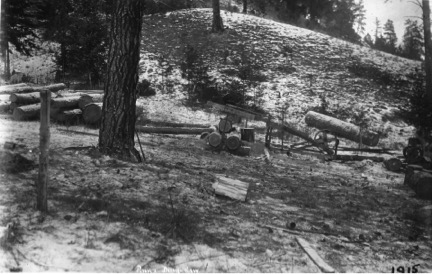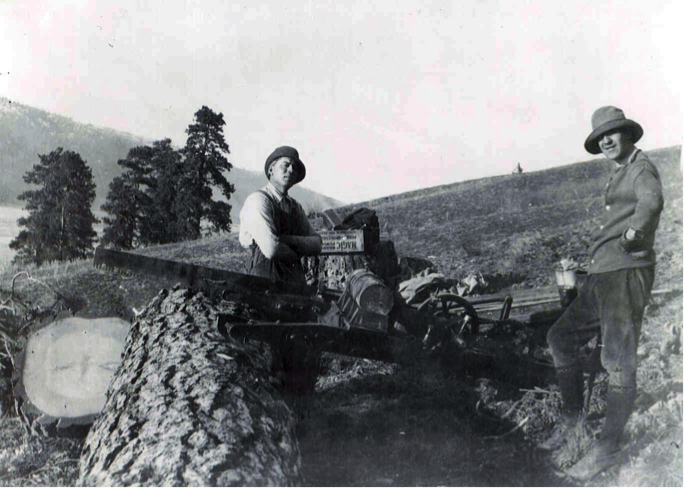Chain saws are so plentiful today that it is difficult to think of forestry or home gardening without the use of this lightweight portable saw. Chain saws are a twentieth century development, the first being developed in 1918 by a Canadian millwright, James Shand. It wasn’t until 1926 that the Swiss engineer, Andreas Stihl, patented and developed an electric chainsaw. The next year a German, Emil Lerp, patented, developed and began mass-producing relatively lightweight, gasoline-powered chainsaws. At 125 lbs., Lerp’s saw was a two-man operation. North American production of chainsaws developed during WWII when importation of equipment from Germany was discontinued.
Before the development of the chain saw, sawyers relied on drag saws to buck large logs. These reciprocating crosscut saws were generally powered by a steam engine but gasoline engines were more portable and may have supplanted steam-powered drag saws. Not a great deal is known about the extent of use of drag saws, but some inference can be drawn from photographic evidence. Lake Country Museum and Archives collections have two photographs showing mechanical reciprocating saws.

The first photograph is from the Goulding Collection. Goulding established the Rainsford Ranch along the shores of Kalamalka Lake in 1907 and ran the horse ranch and fruit farm for many years. This 1915 photograph features his drag saw powered by a steam engine cutting blocks of wood from fir logs. These blocks were undoubtedly used for home heating purposes. The device was portable enough to be dragged to a source of logs by the steam tractor.
The second photograph shows Harry Thomson of Oyama (on left) with another man employing a gasoline-powered crosscut saw to buck a pine tree into lengths suitable for hauling and making lumber. This photograph appears to have been taken on the Commonage. The most likely date of this photograph is 1909. (Harry Thomson came to the North Okanagan as a twenty-three year old in 1908, having married Nina Smith, the daughter of the successful Vernon sawmill owner, S. C. Smith. He only managed a couple of years working for his father-in-law.)

This photograph appears to feature the new Vaughan drag saw, the earliest of the relatively lightweight two-stroke cycle units to be marketed. The Vaughan drag saw was designed as a complete machine with an engine made specifically for the saw and not “borrowed” from some other use. Vaughan drag saws came on a wood frame. The cooling system was a small water tank with a thermo-siphon and no water pump. The ignition utilized a battery and buzz coil to power the spark plug. These saws were manufactured by the Harsch Machine Works of Portland, Oregon and came on the market in early 1909. This photograph likely recorded its first use in the Okanagan.
Readers are encouraged to make observations and add information about the use of drag saws in the early twentieth century. Share the blog with knowledgeable old-timers.
Source: Photographs from the Lake Country Museum & Archives.







0 Comments